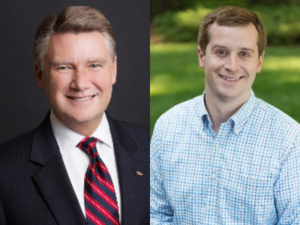With just over two weeks until the Presidential election, former Vice President Joe Biden leads President Donald Trump nationally—by 10.3 points according to FiveThirtyEight’s aggregate and 8.6 points according to RealClearPolitics’ aggregate. A closer look into the states of Michigan, Florida, Iowa, Ohio, Pennsylvania, and Wisconsin—six states that voted for Trump in 2016 while previously being toss-ups or slightly Democratic leaning and going to Obama in 2008 and 2012 alike—reveals the state of this election even further. According to FiveThirtyEight’s aggregates, in Michigan, Wisconsin, and Pennsylvania, Biden leads by around 6 to 7 points. In Florida, Biden leads by just over 3 points, while Iowa and Ohio are toss-ups well within the margin of error.
The results in 2016 came as an immense shock to many pollsters and pundits. FiveThirtyEight gave Clinton a 71.4% chance of victory. The New York Times gave Clinton a 85% chance of victory. The Huffington Post, somewhat infamously, gave Clinton a 98% chance of victory. Following this debacle, of course, pollsters did not remain stagnant, instead making changes and improvements to their methodology to account for the flaws in the 2016 polling, including weighting for education and attempting to account for uncertainty in voter turn-out. Therefore, while polls are never 100% certain, it can be seen that as of today, Biden definitively has the advantage on Trump.
So, why? What is different in 2020?
Joe Biden vs. Hillary Clinton
The first and perhaps clearest difference between 2016 and 2020 is in who is challenging Donald Trump. The difference in popularity between Joe Biden and Hillary Clinton can be seen very plainly in the favorability ratings. Biden sits at +6.4 favorability rating for the period of time between September 22 and October 13, with as high as a +16 and +17 favorability rating in early October. In contrast, Clinton’s favorability ratings were the exact opposite—in the same period, she averaged around a -9.1 favorability rating.
That in and of itself is a clear and undeniable difference between the two elections—that the candidate opposing Trump in 2016 was so strongly disliked, while the candidate opposing Trump in 2020 is by-in-large well-liked. The reasoning for Clinton’s unpopularity among the population is up for debate. Some point to unconscious sexism—that the idea of a powerful and ambitious woman rubbed people the wrong way— while others point to her seemingly close relationship with Wall Street, her perceived role in the attack on American consulate in Benghazi, and her infamous email scandal.
Joe Biden certainly has his own controversies, such as his cooperation with segregationists in his tenure as Senator, his support of the 1994 crime bill that many allege contributed to mass incarceration, a sexual assault allegation from one of his former staff assistants, and allegations of corruption with regards to his son’s appointment on the board of a Ukrainian gas company. But thus far, while Trump has certainly not been shy to speak of these issues, recently pressing on his Hunter Biden accusations, it simply hasn’t caught on as it did last time around. Trump’s nickname of “Crooked Hillary” was an effective tool in 2016, but in 2020 he is struggling to get that same effect with Biden.
That’s not to say that there aren’t notable similarities between Joe Biden and Hillary Clinton—especially their role in the “establishment.” Clinton was seen as a firmly establishment figure in 2016, having been First Lady from 1993 to 2001, Senator from 2001 to 2009, and Secretary of State from 2009 to 2013. Biden is also a firm member of the Democratic establishment, serving in the Senate from 1973 to 2009 and as Vice President from 2009 to 2017.
And that brings us to the next difference between 2016 and 2020: Trump’s role in the establishment.
Trump and the Establishment
There’s no question that, in 2016, Donald Trump rode a wave of anti-establishment sentiment. Perhaps best categorized by the phrase “drain the swamp,” Trump utilized his own status as a political outsider and Clinton’s status as an “insider” to great effect. Using the language of right-wing populists to stir his base into a frenzy, his victory in the Rust Belt and his election as a whole served as a clear repudiation of the establishment.
But his actual presidency failed to live up to the hype. From the outset, his transition team was chock full of the D.C. insiders he railed against. His pick for Secretary of the Treasury, Steve Munchin, was a veteran of Goldman Sachs and even was the CEO of OneWest Bank, with allegations that he “made money off the housing calamity.” Trump, for a few months, had sixteen top CEOs—the embodiment of the “elite” and the “establishment”—as advisors. He failed to fully live up to his promise of a 5-year ban on White House and congressional officials lobbying. More recently, he turned to the “establishment” for help in managing his 2020 campaign amid a recession.
In addition to Trump’s cabinet officials and advisors being full of “insiders,” Trump and his family are also directly implicit in many shady dealings. Jared Kushner and Ivanka Trump, Trump’s son-in-law and daughter respectively, are both high level advisors within the administration—and reportedly earned at least $36 million in outside income, raising major conflict of interest issues. In divergence from tradition, Trump himself refused to divest from his businesses. A revealing New York Times report showed, in addition to Trump having only paid $750 in income federal income tax in 2016 and 2017, that Trump’s properties have “become bazaars for collecting money directly from lobbyists, foreign officials and others seeking face time, access or favor.”
With four years of catering to the establishment under his belt, not to mention his own past and current questionable business dealings, there’s no denying it—Trump is the epitome of the “establishment.” In 2020, he can’t channel the populist rhetoric he ran on in 2016 and blame those in power for America’s problems—he is the one in power, and as President Harry Truman put it: “the buck stops here.”
COVID-19
Perhaps the most important issue of this election is COVID-19. With over 216,000 (and counting) Americans dead from the virus, Trump’s response—or lack thereof— is possibly his biggest failure.
From the beginning, he downplayed the severity of COVID-19. Despite knowing about the dangers of COVID-19 in February, at a press conference following a coronavirus task force briefing on February 26, he compared it to the flu. “But that’s [the symptoms of COVID-19] a little bit like the flu. It’s a little like the regular flu that we have flu shots for. And we’ll essentially have a flu shot for this in a fairly quick manner” the President commented. He undermined the CDC’s suggestion of wearing a mask, saying on April 3 that masks were a “voluntary thing,” and that he was “choosing not to do it,” despite evidence that it does help slow the spread.
Trump urged patients to take hydroxychloroquine to treat COVID-19; the FDA later warned of the severe risks of taking the drug. He suggested exposure to UV light and injecting disinfectant; UV radiation can lead to cancer, and injecting disinfectant is potentially fatal. He tweeted support for protests in Michigan against closure efforts made by Governor Gretchen Whitmer to combat the spread of COVID-19. It was later revealed that some of those at these protests were planning to kidnap or kill Governor Whitmer in a terrorist plot. He blamed blue states for the high infection rates (despite high infection rates in a number of red states), needlessly politicizing the deadly pandemic. He held an indoor rally in Tulsa, Oklahoma, with over 6,000 attendees, despite the clear consequences of holding large, indoor public events in the midst of a pandemic.
The list goes on and on.
Time after time, Trump has either missed opportunities to make a proper response to the pandemic, or took these opportunities to stoke divisive fires and undermine efforts by the states and the CDC to promote safety measures, culminating in his positive diagnosis following a superspreader event in the Rose Garden that left at least 35 infected.
In contrast to Trump’s lack of response and anti-science rhetoric, Biden has released his own plan to respond to COVID-19, which included “stop[ping] the political theatre and willful misinformation,” and “ensur[ing] that public health decisions are made by public health professionals and not politicians.” Biden has made the mask a symbol of his campaign, ironically drawing mockery from Trump mere days before his own positive diagnosis.
The bar is on the floor, but Biden’s contrast to Trump is potentially quite effective, with evidence that senior citizens—a key demographic that helped propel Trump to victory in 2016— may be flipping on him due to their own vulnerability to COVID-19 and Trump’s approach to handling it.
The Main Takeaway
While these are only some of the differences between 2016 and 2020—not to mention increased Democratic engagement, the impact of the death of Justice Ruth Bader Ginsburg on September 18, and general exhaustion, among others—one thing is incredibly clear: it is no longer 2016 anymore.



